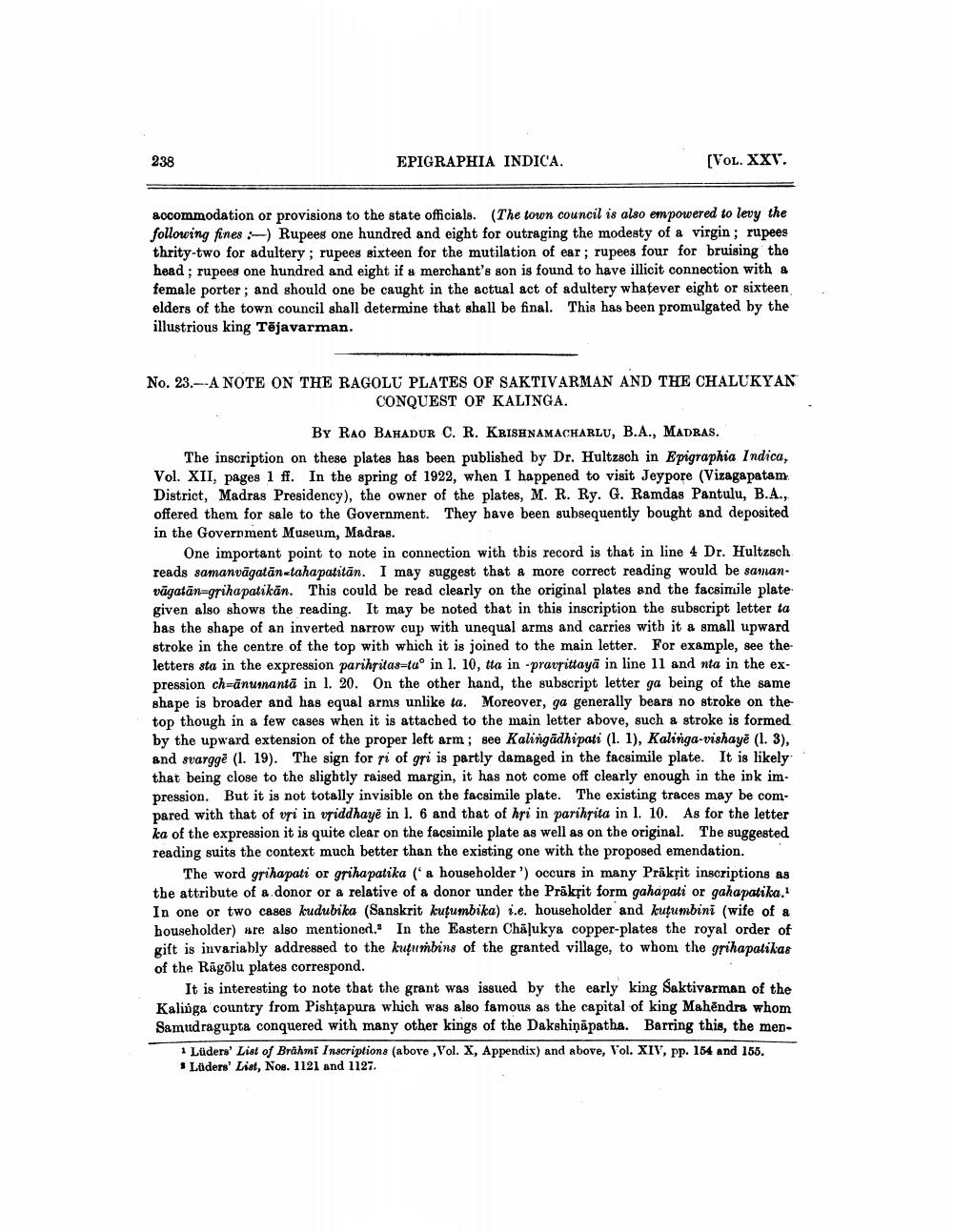________________
238
EPIGRAPHIA INDICA.
[Vol. XXV.
accommodation or provisions to the state officials. (The town council is also empowered to levy the following fines :-) Rupees one hundred and eight for outraging the modesty of a virgin; rupees thrity-two for adultery; rupees sixteen for the mutilation of ear; rupees four for bruising the head; rupees one hundred and eight if a merchant's son is found to have illicit connection with a female porter; and should one be caught in the actual act of adultery whatever eight or sixteen elders of the town council shall determine that shall be final. This has been promulgated by the illustrious king Tējavarman.
No. 23.--A NOTE ON THE RAGOLU PLATES OF SAKTIVARMAN AND THE CHALUKYAN
CONQUEST OF KALINGA.
BY RAO BAHADUR C. R. KRISHNAMACHARLU, B.A., MADRAS. The inscription on these plates has been published by Dr. Hultzsch in Epigraphia Indica, Vol. XII, pages 1 ff. In the spring of 1922, when I happened to visit Jeypore (Vizagapatam, District, Madras Presidency), the owner of the plates, M. R. Ry. G. Ramdas Pantulu, B.A., offered them for sale to the Government. They bave been subsequently bought and deposited in the Government Museum, Madras.
One important point to note in connection with this record is that in line 4 Dr. Hultzsch reads samanvāgatan-tahapatitān. I may suggest that a more correct reading would be samanvāgatān=grihapatikān. This could be read clearly on the original plates and the facsimile plate given also shows the reading. It may be noted that in this inscription the subscript letter ta has the shape of an inverted narrow cup with unequal arms and carries with it a small upward stroke in the centre of the top with which it is joined to the main letter. For example, see the letters sta in the expression parihsitas-tao in 1. 10, tta in pravrittaya in line 11 and nta in the expression ch=ānunantā in 1. 20. On the other hand, the subscript letter ga being of the same shape is broader and has equal arms unlike ta. Moreover, ga generally bears no stroke on the top though in a few cases when it is attacbed to the main letter above, such a stroke is formed by the upward extension of the proper left arm; see Kalingādhipati (1. 1), Kalinga-vishayē (1. 3), and svargge (1. 19). The sign for ri of gri is partly damaged in the facsimile plate. It is likely that being close to the slightly raised margin, it has not come off clearly enough in the ink impression. But it is not totally invisible on the facsimile plate. The existing traces may be compared with that of vri in vsiddhaye in 1. 6 and that of hri in parihrita in 1. 10. As for the letter ka of the expression it is quite clear on the facsimile plate as well as on the original. The suggested reading suits the context much better than the existing one with the proposed emendation.
The word grihapati or grihapatika a householder ') occurs in many Prākțit inscriptions as the attribute of a donor or a relative of a donor under the Präksit form gahapati or gahapatika. In one or two cases kudubika (Sanskrit kutumbika) i.e. householder and kutumbini (wife of a householder) are also mentioned. In the Eastern Chāļukya copper-plates the royal order of gift is invariably addressed to the kutumbins of the granted village, to whom the grihapatikas of the Rāgõlu plates correspond.
It is interesting to note that the grant was issued by the early king Saktivarman of the Kaliūga country from Pishtapura which was also famous as the capital of king Mahendra whom Samudragupta conquered with many other kings of the Dakshiņāpatha. Barring this, the men
1 Lüders' List of Brahmi Inscriptions (above , Vol. X, Appendix) and above, Vol. XIV, pp. 154 and 155. * Lüders' List, Nos. 1121 and 1127.




